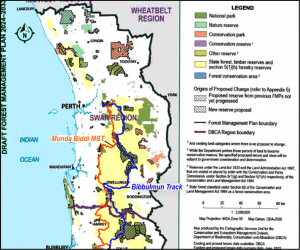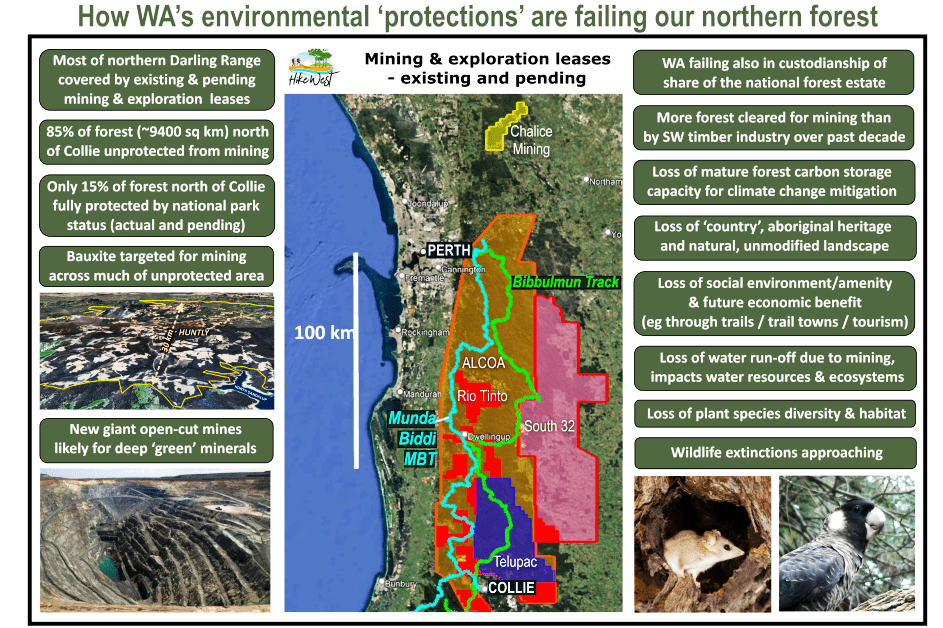The WA State Government released the draft 10-year Forest Management Plan 2024-2033 (‘draft FMP’) on 18 October for a two month public comment period ending 18 December 2022. The draft was prepared by the DBCA for the Conservation and Parks Commission.
The government has hailed the draft plan as an “historic” one that would “preserve forests for future generations in the fight against climate change”, referring to the planned end of native forest logging in the south west from 2024.

In fact more than 60% of WA’s clearing of forests over the past decade has been for mining in the northern jarrah forest, unrelated to the south west timber industry’s logging operations.
And the land categories proposed in the draft FMP (Map 12, p.58) indicate no change in existing and previously proposed protection for the northern forests from the previous 10-year plan. Under the draft plan ~85% of the northern forest area from Collie to north of Perth will remain unprotected from mining. The small scattered national park areas (existing and proposed) are destined to become islands of remnant, quality forest habitat surrounded by degraded forest and landscape, a consequence of the inexorable expansion of mining.
Despite some “new directions” (p.2-5), a ‘carry-on-regardless’ approach to protection of the northern jarrah forest is clear from the draft FMP. This plan will reinforce the protection failures also under the Regional Forest Agreement, the previous FMP (2014-2023), and the ongoing conflicts for government under the Environmental Protection Act and the (non-transparent) State Agreements with miners. It also highlights why a comprehensive strategic assessment of this northern region is urgently needed so government confronts the ‘bigger picture’ and addresses:
ii) implications and mitigations for an environmentally sustainable future.

The draft FMP has also been referred (on 1 November 2022) to the Environmental Protection Authority (EPA) by the Conservation and Parks Commission, as required under the EP Act. After initial review of the draft the EPA will publish the referral information for seven days to seek public input on the level of assessment that the proposal should be subject to. If the EPA determines that the FMP will be assessed via the Public Environmental Review (PER) process it will then announce a public consultation period. Given that the DBCA is both the originator and a key stakeholder in the draft plan, HikeWest considers the appropriate level of assessment will be via the PER process so that public concerns receive the EPA’s direct and independent attention.
References and Other Reading
- “Bauxite mining”, HikeWest, page on this website.
- “‘Beyond 2024’: A beacon of hope for our forests?”, HikeWest, 30 Nov. 2022, post on this website.
- “Defining and Creating New Protected Areas in the South West Forests Beyond 2024“ by DJ Martin, The Beeliar Group and The Leeuwin Group, Oct. 2022.
- Forest Management Plan 2024-2033- A plan for managing our state’s south-west forests, WA Conservation and Parks Commission.
- “Historic new plan to protect WA’s forests”, State Government Media Statement, 18 Oct. 2022.
- “The McGowan logic – sustainable native forest logging not environmentally acceptable, but widespread clearing of jarrah forest for bauxite is”, Robert Onfray, 6 May 2022, in Australian Rural & Regional News.
- “To run or tread water on national parks”, HikeWest, 12 Oct. 2022, post on this website.
- The thousand cuts report – bauxite mining’s #1 role in deforestation in Western Australia – HikeWest review article, this website, May. 2022.
(Posted 6 November 2022.)
View more news updates